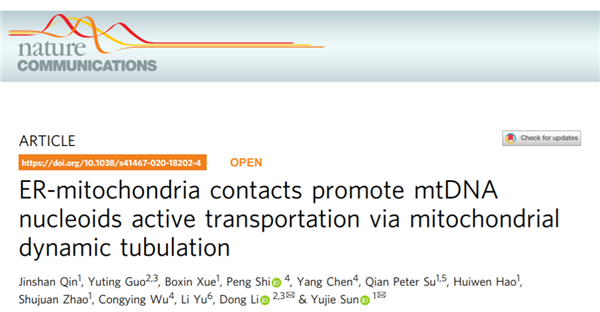Home> Science Outreach
Chinese research teams identify active transportation mechanism of nucleoids
Updated: 2020-09-11

The paper by Chinese researchers published in Nature Communications journal on Sept 8. [Photo/WeChat account of BSC]
A researcher paper -- entitled "ER-mitochondria contacts promote mtDNA nucleoids active transportation via mitochondrial dynamic tabulation" -- was published in the journal Nature Communications on Sept 8, revealing an active transportation mechanism for nucleoids identified by Chinese research groups.
That's according to a statement on the WeChat account of the Biophysical Society of China, or the BSC.
The findings were the fruit of cooperation between a research team led by Sun Yujie from the Biomedical Pioneering Innovation Center (BIOPIC), Peking University and research team led by Li Dong from the Institute of Biophysics, Chinese Academy of Sciences.
The research unveils an active mtDNA transportation mechanism, based on a link spanning from mitochondrial inner matrix-localized mtDNA to motor protein KIF5B at the ER–mitochondria contact sites (EMCS). This greatly advances understanding of mtDNA partitions and distributions in the cell.
According to researchers, a human cell contains hundreds to thousands of mitochondrial DNA (mtDNA), packaged into nucleoids. Currently, the segregation and allocation of nucleoids are thought to be passively determined by mitochondrial fusion and division.
In the paper, the researchers provided evidence, using live-cell super-resolution imaging, that nucleoids can be actively transported. This is via KIF5B-driven mitochondrial dynamic tubulation (MDT) activities, that predominantly occur at the ER-mitochondria contact sites (EMCS).
They further demonstrated that a mitochondrial inner membrane protein complex MICOS links nucleoids to Miro1, a KIF5B receptor on mitochondria, at the EMCS.
The also showed that such active transportation is a mechanism essential for the proper distribution of nucleoids in the peripheral zone of the cell.
